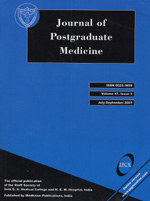
|
Journal of Postgraduate Medicine
Medknow Publications and Staff Society of Seth GS Medical College and KEM Hospital, Mumbai, India
ISSN: 0022-3859
EISSN: 0022-3859
Vol. 57, No. 3, 2011, pp. 196-200
|
 Bioline Code: jp11053
Bioline Code: jp11053
Full paper language: English
Document type: Research Article
Document available free of charge
|
|
|
Journal of Postgraduate Medicine, Vol. 57, No. 3, 2011, pp. 196-200
| en |
Knowledge, attitude and practice of pediatric critical care nurses towards pain: Survey in a developing country setting
Mathew, P J.; Mathew, J L. & Singhi, S
Abstract
Background: Nurses′ knowledge, sensitivity and attitudes about pain in children and its management affect their response and therefore management of pediatric pain. Children in critical care units undergo more painful procedures than those in general wards.
Aims: To study the knowledge, attitude and practice of nursing personnel catering to critically ill children in a developing country.
Settings and Design: Prospective questionnaire-based survey.
Materials and Methods: The survey was carried out in a tertiary care teaching hospital on nursing personnel in three pediatric/neonatal intensive care units. The domains studied were: i. Training and experience, ii. Knowledge of pediatric pain, iii. Individual attitude towards pain in children, iv. Personal practice(s) for pain alleviation, v. Pain assessment, and vi. Non-pharmacological measures adopted.
Statistical Analysis: Descriptive statistics and logistic regression.
Results: Of the 81 nursing personnel working in the three critical care units, 56 (69.1%) responded to the questionnaire. Only one-third of them had received formal training in pediatric nursing. Fifty percent of the respondents felt that infants perceive less pain than adults. Training in pediatric nursing was a significant contributing factor in the domain of knowledge (P=0.03). Restraint and distraction were the common modalities employed to facilitate painful procedures. Scientific approaches like eutectic mixture of local anesthetic and the judicious use of sedatives were not adopted routinely. Observing a child′s face and posture were widely used parameters to assess pain (83%). None of the three critical care areas used a scoring system to assess pain.
Conclusions: There are several lacunae in the knowledge and practice of nurses in developing countries which need to be improved by training.
Keywords
Attitude, critical care, knowledge, nursing personnel, pediatric pain, practice
|
| |
© Copyright 2011 Journal of Postgraduate Medicine.
Alternative site location: http://www.jpgmonline.com
|
|
